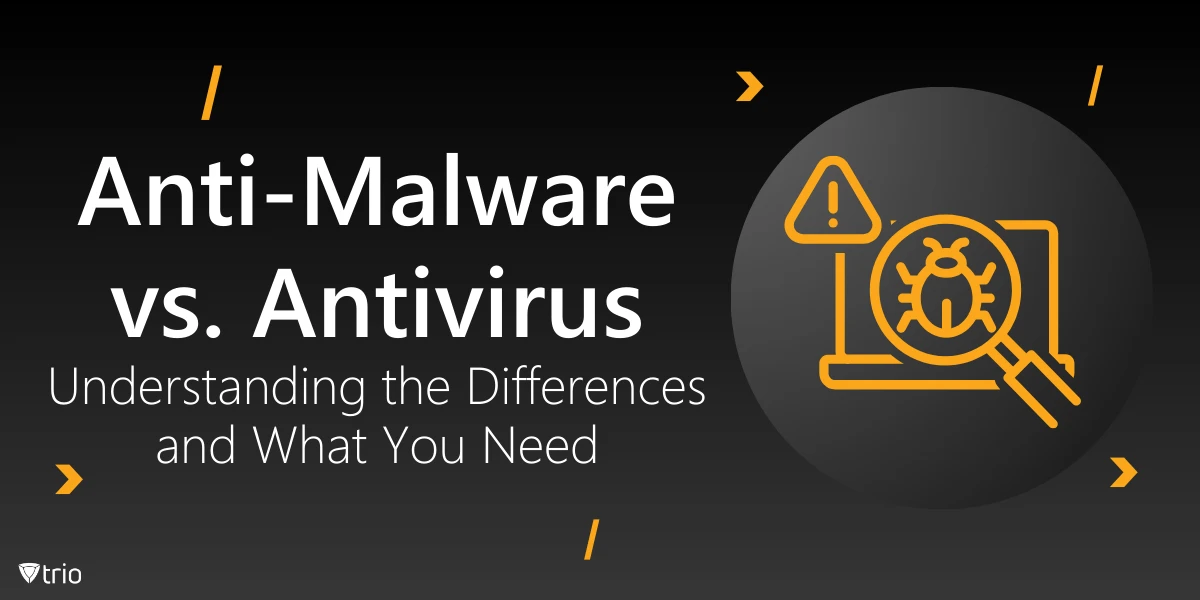In today’s cybersecurity landscape, the terms anti-malware and antivirus are often used interchangeably, but they refer to different solutions. While both are designed to protect your devices and networks from malicious software, the threats they target and how they operate can vary. This blog will compare anti-malware vs antivirus programs, what threats they address, and how to decide which one (or both) your business needs.
What Is Antivirus Software?
The meaning of antivirus software refers to one of the oldest security tools designed to detect, prevent, and remove viruses. Initially, viruses were the primary threat to computer systems—programs designed to replicate themselves and infect other systems. Over time, the scope of antivirus programs expanded to protect against a wider range of threats including the worst computer viruses. Key features of how we define virus protection software include:
- Signature-based detection: Antivirus relies on databases of known virus signatures to identify and block threats.
- Scanning: Antivirus regularly scans files, programs, and websites for known threats.
- Quarantine and Removal: When a virus is detected, antivirus software quarantines and removes the threat from the system.
Common Threats Addressed by Antivirus Software
- Viruses: Self-replicating programs that can spread across devices and networks.
- Worms: Malware that spreads without human intervention, often through email or network connections.
- Trojan Horses: Malicious software disguised as legitimate files or programs.
While antivirus programs are effective at blocking traditional threats like viruses, they may not be as effective against newer, more sophisticated forms of malware.
What Is Anti-Malware Software?
Anti-malware software is a broader category of cybersecurity tools designed to protect against all types of malicious software (malware), including viruses, but also more advanced threats like ransomware, spyware, and adware.
Unlike traditional antivirus programs, anti-malware solutions are specifically designed to address modern threats that antivirus programs may not catch. Anti-malware tools often include advanced detection techniques that go beyond signature-based methods, such as behavior-based analysis and real-time protection. There are currently one billion malware programs in the world.
Common Threats Addressed by Anti-Malware Software
- Ransomware: Malware that encrypts your data and demands payment for decryption.
- Spyware: Software that covertly collects information from your device, such as passwords or browsing habits.
- Adware: Unwanted programs that display intrusive ads or redirect your browser.

Key Differences Between Anti-Malware and Antivirus
While both anti-malware and antivirus tools aim to protect your system and are part of implementing a vulnerability management strategy, there are some key differences in how they work and the threats they target.
-
Scope of Protection
- Antivirus primarily focuses on preventing traditional threats like viruses, worms, and Trojans.
- Anti-malware covers a wider range of threats, including ransomware, spyware, adware, and more sophisticated forms of malware.
-
Detection Techniques
- Antivirus often relies on signature-based detection, which involves comparing files and programs to a database of known virus signatures. While this is effective for known threats, it may not catch newer, unknown malware.
- Anti-malware typically uses behavior-based detection and other advanced techniques to identify suspicious activity, even if the malware does not match a known signature. This allows anti-malware software to detect and block zero-day threats.
-
Focus on Real-Time Protection
- Antivirus programs often scan systems periodically or upon request to detect and remove threats. They may not always offer real-time protection against rapidly evolving threats.
- Anti-malware software is designed to provide real-time protection, constantly monitoring your system for any suspicious activity and blocking threats before they can cause harm.
-
Frequency of Updates
- Antivirus software typically relies on frequent updates to its virus signature database to stay effective. If the database is outdated, the program may fail to detect new viruses.
- Anti-malware solutions tend to receive more frequent updates and use more sophisticated detection techniques, which makes them more adept at protecting against the latest threats.
Malware vs Virus: Which is More Threatening?
In many cases, the best approach to securing your devices and networks is to use both antivirus and anti-malware software. Here’s why:
Comprehensive Protection
By combining the strengths of antivirus and anti-malware programs, you can ensure comprehensive protection against a wide range of threats. Antivirus software will protect you from older, well-known threats, while anti-malware software will defend against newer, more sophisticated attacks like ransomware and spyware.
Layered Security
Using both solutions creates a layered security approach, which is always recommended in cybersecurity. If one program misses a threat, the other can catch it, reducing the chances of a successful attack.
Enhanced Real-Time Defense
While antivirus programs focus on scanning and removing threats after they’ve been detected, anti-malware tools provide real-time protection, stopping threats before they can infiltrate your system.
Conclusion: Which Should You Choose?
When it comes to choosing between antivirus and anti-malware, the answer is that you often need both. While antivirus software offers excellent protection against traditional threats like viruses and worms, anti-malware provides more advanced defenses against modern threats like ransomware and spyware.
For businesses, especially those using Trio, a Mobile Device Management (MDM) solution, ensuring that all devices are equipped with both antivirus and anti-malware software is critical to maintaining a secure environment. Try out Trio’s free trial to experience the cutting-edge technology first-hand! By adopting a layered approach to cybersecurity, you can minimize the risk of data breaches, malware infections, and other cyber threats.
Know about news
in your inbox
Our newsletter is the perfect way to stay informed about the latest updates,
features, and news related to our mobile device management software.
Subscribe today to stay in the know and get the most out of your mobile
devices with our MDM solution app.
Recent Posts

Erase the Risk: Protect with Zero Standing Privileges
Learn how zero standing privileges eliminate persistent access rights, enhance data security and reduce the risk of unauthorized access.

Understanding Access Control Types in Cybersecurity w/ Examples
Thorough understanding of access control types & the knowledge to make informed decisions about implementing security measures in your organization.

Cloud Data Protection: Safeguarding Information in the Cloud
Learn essential strategies for robust cloud data protection, exploring tools, best practices, and policies that safeguard sensitive information.





